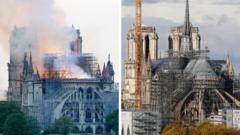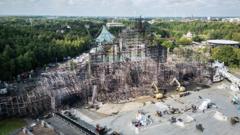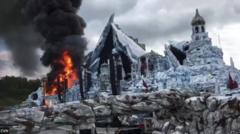The restoration project has restored not only the iconic structure but also uncovered hidden historical treasures, enhancing its cultural significance.
Reviving a Gothic Masterpiece: The Spectacular Restoration of Notre-Dame Cathedral

Reviving a Gothic Masterpiece: The Spectacular Restoration of Notre-Dame Cathedral
A detailed exploration of Notre-Dame Cathedral's remarkable renovation following the devastating 2019 fire.
Notre-Dame Cathedral, the iconic centerpiece of Paris, has undergone a monumental restoration following the catastrophic fire of 2019, which devastated much of its structure. French President Emmanuel Macron recently showcased the cathedral's transformation, revealing to the public a heartening view of the progress made since the blaze. The renovations extend far beyond simple repairs; they involve an intricate overhaul that has scrubbed away years of grime and soot, unveiling the cathedral's former brilliance.
One of the most notable aspects of the restoration is the revival of the spire, which dramatically collapsed during the fire. Contrary to popular belief, the original spire was removed in the 18th century, and the one that burned was reconstructed in a neogothic style by Eugène Viollet-Le-Duc. For the new spire, carpenters merged traditional craftsmanship with modern technology, constructing a robust wooden base lifted by Europe's largest crane. Inside the newly erected spire, a gilded rooster now holds relics of holy significance, including a thorn from the Crown of Thorns and a parchment naming 2,000 contributors to the renovation.
The refurbishment has also rejuvenated the cathedral's exterior, particularly the limestone stonework, which was meticulously cleaned and, in some areas, replaced using stone sourced from northern France. Experts employed advanced techniques to identify specific geological features within the original stone, ensuring authenticity in restoration. Overall, around 40,000 square meters of stone were purified, revealing the luminosity of the material previously obscured by layers of soot and grime.
Within the cathedral, the oak roof—completely consumed by flames—has been reconstructed with wood sourced from French forests. The undertaking, led by architect Remi Fromont, involved locating 1,200 straight, knot-free oak trees to mimic the original timbers from the 13th century, with craftspeople employed traditional methods of shaping the wood.
Many famous exterior sculptures, including gargoyles and chimeras, were damaged during firefighting efforts. A specialized workshop was set up for restoration, where several gargoyles were scanned and recreated in limestone. Internally, key sculptures emerged undamaged from the fire, although all benefited from thorough cleaning and minor repairs, contributing to the cathedral's overall revival.
In addition to rejuvenating the visual aspects, the cathedral also regained its vibrancy through the restoration of stained-glass windows, which were painstakingly cleaned to reveal their original colors. This effort has returned a brilliant spectrum of blues, reds, and golds, markedly enhancing the lightness of the interior atmosphere.
The 18th-century Great Organ, although untouched by the flames, suffered due to lead monoxide accumulation in its pipes. It underwent a comprehensive restoration process, culminating in the re-tuning of its 7,952 pipes. Visitors will soon hear the magnificent instrument echo throughout the cathedral, as it ushers in a new era of worship.
Significant changes have also been made to the liturgical layout of the space, with the introduction of a simple bronze altar, new chalices, and seating for the congregation. A reliquary for the Crown of Thorns was also crafted, further anchoring its spiritual significance within the rebuilt structure.
Archaeological excavations at the cathedral revealed astonishing discoveries, including remains dating back to well before the cathedral’s construction. The remnants of a 13th-century rood-screen, carefully buried, are particularly intriguing, with hopes of reconstruction for future display.
Despite the extensive repairs, restoration efforts continue, with plans for further enhancements to the exterior and the creation of a museum in the adjacent Hôtel-Dieu hospital. The resurgence of Notre-Dame Cathedral stands as a testament not only to architectural ingenuity but also to the enduring spirit of Paris and its cultural heritage.
One of the most notable aspects of the restoration is the revival of the spire, which dramatically collapsed during the fire. Contrary to popular belief, the original spire was removed in the 18th century, and the one that burned was reconstructed in a neogothic style by Eugène Viollet-Le-Duc. For the new spire, carpenters merged traditional craftsmanship with modern technology, constructing a robust wooden base lifted by Europe's largest crane. Inside the newly erected spire, a gilded rooster now holds relics of holy significance, including a thorn from the Crown of Thorns and a parchment naming 2,000 contributors to the renovation.
The refurbishment has also rejuvenated the cathedral's exterior, particularly the limestone stonework, which was meticulously cleaned and, in some areas, replaced using stone sourced from northern France. Experts employed advanced techniques to identify specific geological features within the original stone, ensuring authenticity in restoration. Overall, around 40,000 square meters of stone were purified, revealing the luminosity of the material previously obscured by layers of soot and grime.
Within the cathedral, the oak roof—completely consumed by flames—has been reconstructed with wood sourced from French forests. The undertaking, led by architect Remi Fromont, involved locating 1,200 straight, knot-free oak trees to mimic the original timbers from the 13th century, with craftspeople employed traditional methods of shaping the wood.
Many famous exterior sculptures, including gargoyles and chimeras, were damaged during firefighting efforts. A specialized workshop was set up for restoration, where several gargoyles were scanned and recreated in limestone. Internally, key sculptures emerged undamaged from the fire, although all benefited from thorough cleaning and minor repairs, contributing to the cathedral's overall revival.
In addition to rejuvenating the visual aspects, the cathedral also regained its vibrancy through the restoration of stained-glass windows, which were painstakingly cleaned to reveal their original colors. This effort has returned a brilliant spectrum of blues, reds, and golds, markedly enhancing the lightness of the interior atmosphere.
The 18th-century Great Organ, although untouched by the flames, suffered due to lead monoxide accumulation in its pipes. It underwent a comprehensive restoration process, culminating in the re-tuning of its 7,952 pipes. Visitors will soon hear the magnificent instrument echo throughout the cathedral, as it ushers in a new era of worship.
Significant changes have also been made to the liturgical layout of the space, with the introduction of a simple bronze altar, new chalices, and seating for the congregation. A reliquary for the Crown of Thorns was also crafted, further anchoring its spiritual significance within the rebuilt structure.
Archaeological excavations at the cathedral revealed astonishing discoveries, including remains dating back to well before the cathedral’s construction. The remnants of a 13th-century rood-screen, carefully buried, are particularly intriguing, with hopes of reconstruction for future display.
Despite the extensive repairs, restoration efforts continue, with plans for further enhancements to the exterior and the creation of a museum in the adjacent Hôtel-Dieu hospital. The resurgence of Notre-Dame Cathedral stands as a testament not only to architectural ingenuity but also to the enduring spirit of Paris and its cultural heritage.























